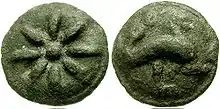Aes grave
Aes grave (heavy bronze) is a term in numismatics indicating bronze cast coins used in central Italy during the 3rd century BC, whose value was generally indicated by signs: I for the as, S for semis and pellets for unciae. Standard weights for the as were 272, 327, or 341 grams, depending upon the issuing authority.[1]
The main Roman cast coins had these marks and images:
| Image | value | mark |
|---|---|---|
| Ianus | As | I |
| Iupiter | Semis | S |
| Minerva | Triens | four pellets |
| Hercules | Quadrans | three pellets |
| Mercury | Sextans | two pellets |
| Bellona or Roma | Uncia | one pellet |
Issuing cities
Main series were from Rome, Ariminum (Rimini), Iguvium (Gubbio), Tuder (Todi), Ausculum (Ascoli Satriano), Firmum (Fermo), Hatria - Hadria (Atri), Luceria (Lucera), and Latin central Italy. Other series have unknown provenance.
Gallery
 As (ca. 235 BC)
As (ca. 235 BC)
 Triens (ca. 241–235 BC)
Triens (ca. 241–235 BC) Quadrans (ca. 230–226 BC. weight 63.19 g
Quadrans (ca. 230–226 BC. weight 63.19 g
Vecchi 61; Crawford 27/8) Sextans (ca. 289–245 BC)
Sextans (ca. 289–245 BC) Quincunx (coin) (After 220 BC)
Quincunx (coin) (After 220 BC)
 Uncia (coin) (ca. 275–270 BC)
Uncia (coin) (ca. 275–270 BC)
See also
References
- Michael H. Crawford (1974). Roman Republican Coinage. Cambridge University Press. pp. 1–. ISBN 978-0-521-07492-6.
Further reading
- Haeberlin, Ernst: Aes Grave, Das Schwergeld Roms und Mittelitaliens einschließlich der ihm vorausgehenden Rohbronzewährung, Halle 1910.
- Head, Barclay V.: Historia Nummorum, a Manual of Greek Numismatic, London, 19112.
- Sear, David: "Roman Coins and Their Values," Volume I, Spink.
- Sydenham, Edward A.: Aes Grave A Study of the Cast Coinages of Rome and Central Italy. London, Spink, 1926.
- Italo Vecchi. Italian Cast Coinage. A descriptive catalogue of the cast coinage of Rome and Italy. London Ancient Coins, London 2013. Hard bound in quarto format, 84 pages, 90 plates. ISBN 978-0-9575784-0-1
This article is issued from Wikipedia. The text is licensed under Creative Commons - Attribution - Sharealike. Additional terms may apply for the media files.